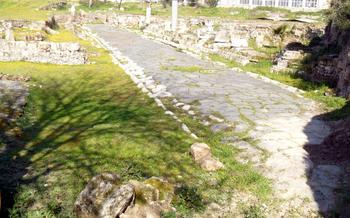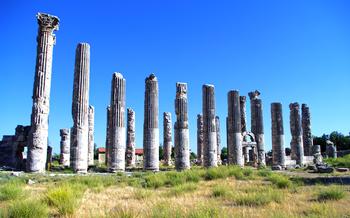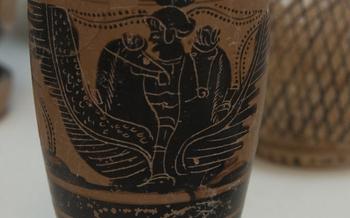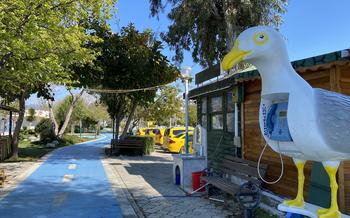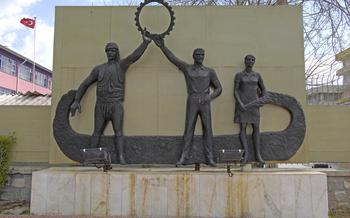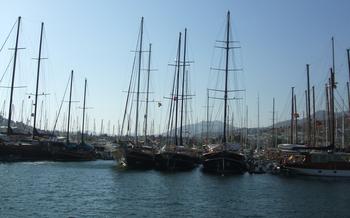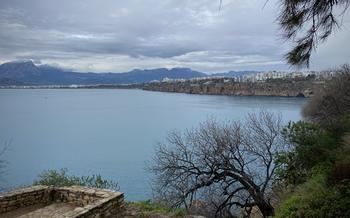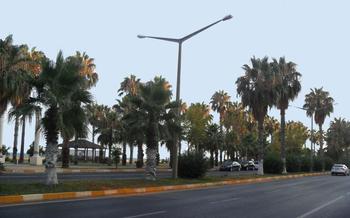
Uzuncaburç Ancient City
- Exploring the Ruins
- Agora: The City's Heart
- Necropolis: Tombs and Burials
- Theatrical Performances
- Religious Sites: Temples and Altars
- Aqueduct System: Engineering Marvel
- Mosaics: Art and Craftsmanship
- Ceramics and Pottery:
- Coins and Currency
- Uzuncaburç Museum: Preserving the Past, Inspiring the Future
- Best Time to Visit
- Getting There: Transportation Options
- Accommodation and Dining
- Insider Tip: Exploring Beyond the Ordinary
Exploring the Ruins
Uzuncaburç offers a fascinating journey into the past, with its well-preserved ruins that tell the story of a once-thriving ancient city. Visitors can wander among the remnants of city walls, which once protected the city from invaders, and admire the towers and gates that provided access to the city. The public buildings, including an impressive agora (marketplace), temples dedicated to various deities, and residential areas, offer insights into the daily life and activities of the ancient inhabitants. Exquisite mosaics, intricate sculptures, and informative inscriptions further enhance the visitor's understanding of the city's history and culture.
Agora: The City's Heart
The agora, the bustling heart of Uzuncaburç, served as a vibrant hub for trade, social gatherings, and political activities. This central square was the epicenter of the city's daily life, where merchants set up their stalls, citizens exchanged goods and ideas, and political debates unfolded.
Surrounding the spacious agora were numerous shops, stoas (covered walkways), and public buildings, creating a lively and diverse urban environment. These stoas provided shelter from the sun and rain, housing a variety of shops selling everything from pottery and textiles to jewelry and spices.
The agora was not just a marketplace; it was also a place for social interaction and political discourse. Here, citizens gathered to discuss important issues, make decisions, and celebrate special occasions. The presence of public buildings, such as the bouleuterion (council chamber) and the prytaneion (government building), further emphasized the agora's significance as the city's administrative and political center.
Archaeological excavations have revealed a wealth of evidence about the daily life and economic activities that took place in the agora. Coins, pottery fragments, and inscriptions shed light on the types of goods that were traded, the prices of commodities, and the various occupations of the city's inhabitants.
Whether you're a history buff, an architecture enthusiast, or simply someone who enjoys exploring ancient ruins, the agora of Uzuncaburç is a must-visit destination. As you wander through the well-preserved remains of this once-bustling city center, you'll get a glimpse into the vibrant world of ancient Uzuncaburç and the people who called it home.
Necropolis: Tombs and Burials
Outside the city walls of Uzuncaburç lies an extensive cemetery, known as the necropolis, providing a glimpse into the funerary practices and beliefs of the ancient inhabitants. The necropolis features a variety of tombs ranging from simple graves to elaborate mausoleums, each reflecting the social status and wealth of the deceased.
Simple graves, often marked by headstones or stelae, were common among ordinary citizens. These graves sometimes contained grave goods such as pottery, jewelry, and coins, which were believed to accompany the deceased into the afterlife.
More elaborate tombs, such as rock-cut tombs and mausoleums, were reserved for wealthy individuals and families. These tombs were often decorated with intricate carvings, sculptures, and inscriptions, showcasing the artistic skills of the period and providing valuable insights into the beliefs and values of the ancient society.
The necropolis also includes a number of underground tombs, known as hypogea, which were carved into the soft rock. These tombs were typically family vaults, with multiple burial chambers arranged around a central courtyard or corridor. The hypogea often featured elaborate frescoes and paintings depicting scenes from mythology, daily life, and religious rituals, offering a glimpse into the worldviews and beliefs of the ancient Uzuncaburç inhabitants.
Theatrical Performances
Amidst the ruins of Uzuncaburç, a well-preserved theater stands as a testament to the city's vibrant cultural life. With a seating capacity of approximately 5,000 spectators, this impressive structure served as a stage for theatrical performances, musical concerts, and other forms of entertainment.
The theater's architectural features reflect the grandeur and sophistication of ancient Roman design. Its horseshoe-shaped auditorium, adorned with tiers of stone seats, rises steeply from the orchestra, providing excellent acoustics and sightlines. The stage, adorned with intricate carvings and decorative elements, is flanked by two imposing towers that once supported a wooden roof, protecting the performers and audience from the elements.
Evidence suggests that the theater was a hub of artistic activity, hosting performances of Greek and Roman plays, comedies, and tragedies. The discovery of masks, costumes, and theatrical props further supports the notion that Uzuncaburç's theater played a significant role in the city's cultural and social life.
Attending a theatrical performance in this ancient theater would have been a captivating experience for the citizens of Uzuncaburç. The atmosphere would have been electric, with the audience eagerly anticipating the unfolding drama on stage. The actors, adorned in elaborate costumes and masks, would have brought to life the tales of gods, heroes, and ordinary mortals, immersing the spectators in a world of laughter, tears, and wonder.
Today, visitors to Uzuncaburç can still marvel at the grandeur of this ancient theater. Although the stage is no longer adorned with colorful sets and the seats are worn and weathered, the theater's acoustics remain remarkable, allowing visitors to experience the same sense of awe and wonder that the original audience must have felt centuries ago.
Religious Sites: Temples and Altars
Uzuncaburç was home to several religious sites, reflecting the diverse beliefs and practices of its ancient inhabitants. The most prominent deity worshipped was Zeus, the king of the gods in Greek mythology. A majestic temple dedicated to Zeus stood in the heart of the city, showcasing intricate architectural features and awe-inspiring sculptures. Other temples were dedicated to deities such as Apollo, Athena, and Aphrodite, each with their own unique design and significance. Altars, statues, and inscriptions found throughout the ruins provide valuable insights into the religious rituals and practices of Uzuncaburç's ancient population. Exploring these religious sites offers a glimpse into the spiritual beliefs and cultural practices that shaped the lives of this ancient civilization.
Aqueduct System: Engineering Marvel
The ancient city of Uzuncaburç boasted an impressive aqueduct system that provided a vital water supply to its inhabitants. This engineering marvel consisted of an extensive network of underground channels and a towering aqueduct bridge. The aqueduct bridge, a testament to Roman engineering prowess, spanned a considerable distance, transporting water from distant springs or rivers into the city. The underground channels, meticulously constructed, ensured a continuous flow of water throughout the city, supplying public baths, fountains, and residential areas. The aqueduct system not only facilitated daily life but also played a crucial role in maintaining public health and sanitation, demonstrating the advanced urban planning and infrastructure development of the ancient city.
Mosaics: Art and Craftsmanship
Uzuncaburç's ancient city is home to an impressive collection of mosaics that showcase the artistic talents and craftsmanship of its inhabitants. These intricate artworks adorn the floors of public buildings, temples, and private residences, adding a touch of beauty and opulence to the ancient city.
The mosaics depict a wide range of subjects, from mythological scenes to geometric patterns. Some of the most notable mosaics include those depicting the Labors of Hercules, the story of Leda and the Swan, and a stunning geometric mosaic featuring a central medallion surrounded by intricate floral designs.
The mosaics were created using a technique called opus tessellatum, which involved arranging small pieces of colored stone or glass, known as tesserae, to form images or patterns. The tesserae were carefully cut and fitted together to create smooth, continuous surfaces.
The mosaics of Uzuncaburç are not only visually stunning but also offer valuable insights into the artistic styles and cultural influences of the ancient period. They demonstrate the skill and precision of the artisans who created them and provide a glimpse into the daily lives and beliefs of the people who lived in the city.
Ceramics and Pottery:
Uzuncaburç's archaeological excavations have yielded a wealth of ceramic artifacts that provide insights into the domestic life and artistic traditions of its ancient inhabitants. These include ceramic vessels used for various purposes such as storage, cooking, and serving food. The pottery is characterized by its diverse shapes, ranging from simple bowls and plates to intricate jars and jugs. Some vessels feature decorative patterns and motifs, showcasing the artistic skills of the local craftsmen. These ceramic artifacts offer valuable clues about the daily lives of the people who once called Uzuncaburç home.
Coins and Currency
Uzuncaburç's coinage provides valuable insights into the city's economic activities and trade relations. Excavations have yielded a variety of coins, including silver and bronze issues, minted in the city itself. These coins bear the names of local rulers or magistrates, along with symbols and inscriptions that indicate their value and date of issuance.
The study of Uzuncaburç's coinage sheds light on the city's economic prosperity and its participation in regional trade networks. The presence of coins from other cities and regions suggests that Uzuncaburç was a hub for commerce, with goods and services flowing in and out of the city.
Moreover, the coins provide clues about the monetary system in use during Uzuncaburç's time. The variety of denominations and the use of different metals suggest a sophisticated financial system that facilitated transactions of varying sizes and values.
Exploring the coinage of Uzuncaburç offers a glimpse into the economic and commercial aspects of ancient life in this thriving city. Numismatic studies contribute to our understanding of trade routes, monetary practices, and the economic relationships that shaped the development of Uzuncaburç and the wider region.
Uzuncaburç Museum: Preserving the Past, Inspiring the Future
The Uzuncaburç Museum stands as a testament to the rich history and cultural heritage of the ancient city. Within its walls, visitors can embark on a journey through time, exploring a diverse collection of artifacts that bring the past to life.
The museum houses a treasure trove of discoveries from the archaeological excavations, including pottery, coins, sculptures, mosaics, and inscriptions. Each artifact tells a story, shedding light on the daily lives, religious practices, and economic activities of the ancient inhabitants of Uzuncaburç.
Exhibits are arranged in chronological order, allowing visitors to trace the development of the city from its humble beginnings to its rise as a thriving metropolis. Interactive displays and educational resources enhance the museum experience, providing deeper insights into the significance of the artifacts and the broader historical context.
A visit to the Uzuncaburç Museum is not just an educational experience but also an opportunity to appreciate the artistic and cultural achievements of the ancient world. The exquisite mosaics, intricate sculptures, and well-preserved inscriptions offer a glimpse into the creativity and craftsmanship of the people who once called this city home.
Whether you are a history buff, an art enthusiast, or simply curious about the past, the Uzuncaburç Museum is a must-visit destination. Its collection of artifacts and interactive displays provide a captivating and immersive experience that will leave you with a deeper understanding and appreciation of this ancient city.
Best Time to Visit
Timing your visit to Uzuncaburç is crucial for a memorable experience. The ideal period to explore the ancient city is during spring (April-May) and autumn (September-October). During these seasons, the weather is pleasant, with warm and sunny days, making it comfortable for outdoor exploration. The summer months (June-August) can be scorching, with temperatures soaring, which might not be suitable for extended outdoor activities.
Uzuncaburç, like many historical sites, experiences a peak tourist season during the summer months. If you prefer a more tranquil and intimate exploration, consider visiting during the shoulder seasons (May-June and September-October). During this time, you'll encounter fewer crowds, allowing you to immerse yourself in the ancient ruins without the hustle and bustle of peak season.
To make the most of your visit, plan your trip around local events and festivals. Mersin hosts various cultural and artistic events throughout the year, including the Mersin International Music Festival and the Mersin Orange Blossom Festival. These events provide an opportunity to experience the vibrant local culture while exploring the ancient city.
Getting There: Transportation Options
Uzuncaburç Ancient City is conveniently accessible by various transportation methods, making it easy for visitors to reach.
Public Transportation: Regular buses connect Uzuncaburç to major cities and towns in the region. From the city of Mersin, buses depart frequently from the main bus station and take approximately 5 hours to reach Uzuncaburç.
Rental Cars: For those who prefer the flexibility of self-driving, rental cars are available at Mersin Airport and in the city center. The drive to Uzuncaburç takes about 1 hour and 15 minutes via the D400 highway.
Guided Tours: Organized tours from Mersin or other nearby cities often include Uzuncaburç Ancient City as part of their itinerary. These tours provide transportation, a knowledgeable guide, and insights into the history and significance of the site.
Tips for Planning Your Journey:
-
To avoid crowds and ensure a more personal experience, plan your visit during the shoulder seasons (spring or fall).
-
Check bus schedules in advance and arrive at the bus station early to secure a seat, especially during peak tourist season.
-
If renting a car, consider the cost of fuel and parking fees, and be prepared for driving on unfamiliar roads.
-
Guided tours can be a convenient option for those who prefer a structured experience and the guidance of an expert.
Accommodation and Dining
Uzuncaburç offers a range of accommodation options to suit different budgets and preferences. For a comfortable and immersive experience, consider staying at one of the charming guesthouses or boutique hotels in the vicinity of the ancient city. These accommodations often feature traditional architecture, local hospitality, and easy access to the historical sites.
When it comes to dining, Mersin is renowned for its culinary delights, blending Turkish and Mediterranean flavors. Indulge in fresh seafood dishes, savor the smoky aromas of grilled kebabs, or try traditional Turkish mezes accompanied by refreshing drinks. Local restaurants and cafes line the streets of Uzuncaburç, offering a variety of dining experiences from casual eateries to fine dining establishments.
For budget-conscious travelers, there are affordable options available, such as family-run restaurants and local markets where you can sample street food and fresh produce. Don't miss the opportunity to try gözleme, a delicious Turkish flatbread filled with savory ingredients, or sip on a cup of Turkish coffee while soaking in the local atmosphere.
Insider Tip: Exploring Beyond the Ordinary
Venturing beyond the main attractions of Uzuncaburç, you'll discover hidden gems that offer unique experiences and stunning photo opportunities. Stroll along the scenic coastline and uncover secluded coves, perfect for peaceful relaxation or capturing breathtaking sunsets. Explore the nearby villages to immerse yourself in authentic Turkish culture, sample local delicacies, and engage with friendly locals. For nature enthusiasts, the surrounding countryside beckons with hiking trails leading to panoramic views and encounters with diverse flora and fauna. Whether it's capturing the essence of a bustling local market, discovering ancient ruins nestled amidst lush greenery, or simply savoring the tranquility of a traditional Turkish coffeehouse, Uzuncaburç offers endless opportunities to create lasting memories and capture the true spirit of this enchanting destination.
